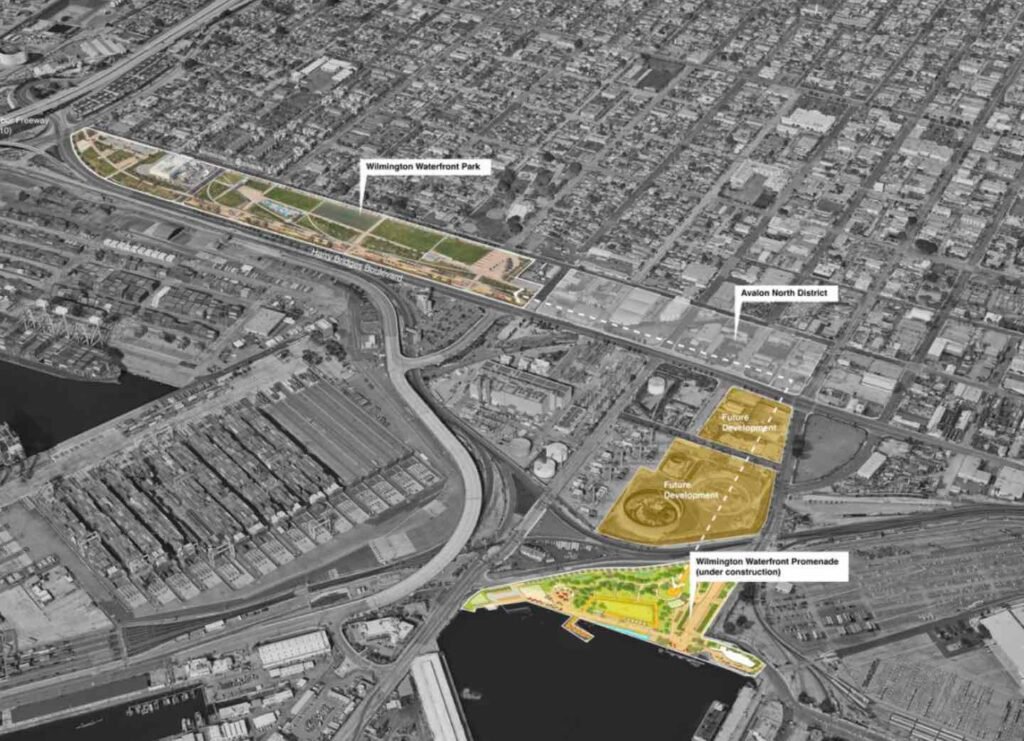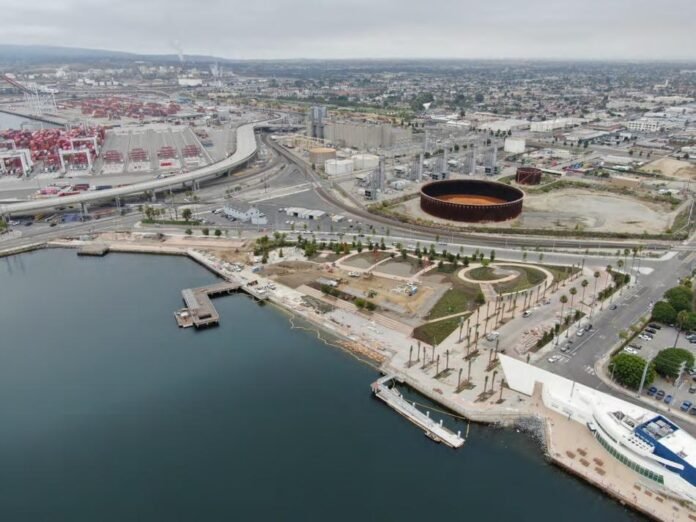The transformation of Wilmington’s waterfront—a three-part development that will see its second part, the Wilmington Waterfront Promenade, open this weekend—is the largest green space projects in one of the region’s most air quality poor neighborhoods.
And it is important not just for the city of Wilmington, but Long Beach and the region as a whole.

What is the Wilmington waterfront project all about?
The nine-acre Waterfront Promenade, opening this Saturday, is the work of design firm Sasaki Associates, who led the design and implementation of the park. They worked together with the Port of Los Angeles and Studio MLA. It is one of a three-pronged green space development that began with the 30-acre Wilmington Waterfront Park and will be completed with the 13-acre Avalon Promenade and Gateway, just north of the Waterfront Promenade.
That latter project will be key, as it will connect the Waterfront Park with the Waterfront Promenade, finding its entry point where Avalon Boulevard hits Harry Bridges Boulevard. Designed by T.Y. Lin International, the space will be home to everything from outdoor classrooms and a history walk to a giant sundial.

While Wilmington residents have long enjoyed the Waterfront Park, the first of the three projects to be completed, the Waterfront Promenade has been over a decade in the making and broke ground in October of 2020.
But it is more than just being a new park space for Wilmington.

Wilmington and West Long Beach are kindred spirits when it comes to poisoned air
Off the cuff, it is recognition that our most at-risk citizens—those near refineries and trains and trucks in West Long Beach, North Long Beach, Carson, and, of course, Wilmington—deserve greener space.
Wilmington is arguably Long Beach’s most marginalized neighbor: Smushed between the 110 and Terminal Island freeways and the port complex to its south, it is home to the nation’s third-largest oil field and represents one of the most industrialized cities in the entire United States.
And that comes with many problems.

In 1999, a massive fire explosion in an oil refinery in Wilmington—just on the westernmost edge of Long Beach—was so large that it shut down the 110 and prompted evacuations of students and residents due to health concerns.
Until then, little restrictions on flaring—burning excess gas into the air around refineries—was not tightly regulated, prompting Sacramento to tell refineries they can only flare during emergencies and maintenance along with having to send monitoring reports on what they released.
Despite these monitor reports, the residents of Wilmington really don’t know how bad a year is going to be or even to what extent living near these industries affect their health.
2018? 10,113.5 pounds of particulate—everything from nitrous oxide to carbon monoxide to sulfur dioxide—were released at Phillip 66’s Wilmington location. 2019? A staggering 44,919.9 pounds of particulate released by the same location.
2020? 4,308.5 pounds of particulate. 2021, the very next year? 38,927.7 pounds of particulate were released into the airs of Wilmington.

What goes on around Long Beach bears our own burden
Sometimes, we over-romanticize the fact that Long Beach lives in a silo. We oftentimes dismiss what others are doing in an intense need to focus on our own to the extent that it’s detrimental.
Ultimately, whether we want to admit it or not, what is going on around us is important—but even more, we have to support projects that make our neighbors healthier, projects that provide our neighbors the chance to receive the benefits that many of us take advantage of. Because that makes us healthier, that makes our benefits increase when we have a population that is on par with what we expect our human condition to be.
In one of the more frustrating points I’ve heard from folks, especially those in Long Beach, when it comes to discussing folks living in Wilmington or its adjacent West Long Beach—the most park-poor area of our entire city, a neighborhood which has to deal with the 710 on a daily basis and the one which bears the biggest pollution burden—I always hear the same rhetoric: “Well then, why did they move there?”

This pontification reeks of self-centeredness, a lack of empathy, and—in all frankness—a willful unawareness.
The reality as to “why they moved there” lies on us: We as humans sold fellow humans homes there because we wanted to make money and they could afford it because humans need roofs over their heads.
Then we hit a point where a mayoral candidate, during a forum I hosted back in 2014, states this: “The West Side? I have no shame in being blasphemous, but the West Long Beach is an unlivable hellhole. The residents should leave and we should turn the entire area into an industrial zone.”
Just turn the entire area into an industrial zone. On our coast. Next to other communities. I refuse to be a part of that camp—and it’s because projects like this exist. Support your neighbors, Long Beach. Fight for a better world, both in and outside our city; it will benefit you far more than you know.
The Wilmington Waterfront Promenade opens Saturday, Feb. 3, 2024.



[…] $77M Wilmington Waterfront Promenade is a win for entire region—especially Long Beach—when it op… “The nine-acre Waterfront Promenade, opening this Saturday, is the work of design firm Sasaki Associates with landscape architecture by Studio MLA. It is one of a three-pronged green space development that began with the 30-acre Wilmington Waterfront Park and will be completed with the 13-acre Avalon Promenade and Gateway, just north of the Waterfront Promenade.” (Longbeachize) […]
Impressive, fantastic!